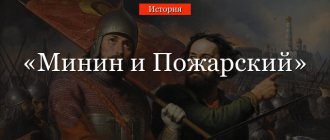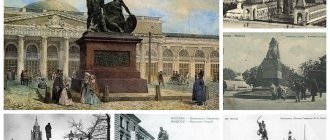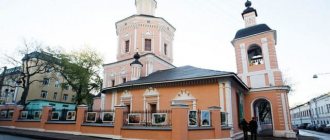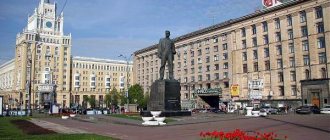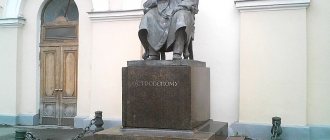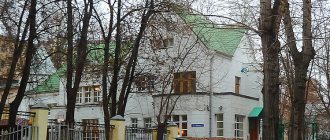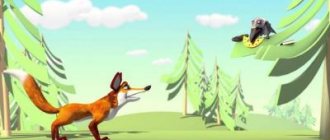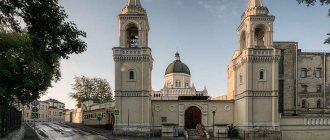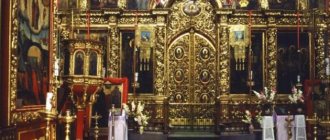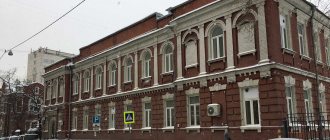Description of the monument
The monument to Minin and Pozharsky is made in the spirit of classicism, which is distinguished by monumental forms and a reference to ancient Greek statues. The pedestal with bas-reliefs deserves special attention.
Sculpture
The sculpture depicts Kuzma Minin, who calls with one hand to rise to defend Moscow from the invaders, and with the other hands the sword to Pozharsky. Pozharsky himself sits on the box and takes the sword with his right hand. With his left hand he leans on a shield depicting the Savior Not Made by Hands. The sword serves as a symbol of the unity of the entire people in the fight against the Polish invaders. The height of the sculpture group is about 4.6 m.
Interesting fact! In the sculptor’s original version, Pozharsky expressively rushed forward, raising the same shield in his hands and holding the sword. Minin just stood there, pointing to Moscow. In the final version, Minin is more dynamic.
Pedestal
The pedestal of the monument is made of three pieces of red granite, which were brought to the stonemason from Finland. The height of the pedestal is about 3.7 m, the width is 2.3 m.
bronze bas-reliefs on both sides . The front depicts people donating their wealth for the good of the Motherland. These include women giving away jewelry and men sending their sons to defend the state.
The bas-relief on the back side of the pedestal depicts the victory of the militia heroes led by Pozharsky on horseback.
The granite is also decorated with a memorial inscription : “To Citizen Minin and Prince Pozharsky, grateful Russia. Summer of 1818."
Characteristics of images
The description of the monument to Minin and Pozharsky suggests that the figure of Minin attracts attention first of all. It forms the semantic center of the monument. With his famous gesture, Kuzma calls on the entire people - not only his contemporaries, but also future generations - to defend the Fatherland from any encroachment on its independence.
The proud face, with its regular expressive features, resembles portraits of heroes of antiquity. But the beard and hair cut with a “bracket” indicate the hero’s clearly Russian, common origin. His shirt, on the one hand, is clearly a peasant blouse. At the same time, it is associated with the Greek chiton. Thus, the description of the monument to Minin and Pozharsky is based on original Russian and ancient traditions. This further exalts the feat of national heroes. It is characteristic that it was the commoner, the townsman, who was chosen by the sculptor for the basis of the composition.
A powerful torso, a long stride - everything radiates with strength, energy, inspiration, confidence in the rightness of the cause in the name of which the hero rose to fight. A monument to Minin and Pozharsky was erected, and the second character of the composition is no less important. Prince Dmitry Mikhailovich is wounded, but Minin’s call does not leave him indifferent. Pozharsky rises from the bed, grabbing his sword with one hand and leaning on his shield with the other. His gestures are also energetic, and one can feel will and determination in his hands. And the image of the Savior on the shield affirms the holiness of the heroism of the defenders of Moscow and Russia. The sword in the sculpture is not only a weapon, but also a symbol of military valor, the unity of aspirations and thoughts of the characters, awakening the consciousness of the people in times of trouble and hard times of war.
Project background
The idea to erect a monument to the militia heroes arose in 1802, but Alexander I did not support it, since he did not find the financial opportunity.
In 1804, Ivan Martos decided to go a little further than the idea and made a small model of the future monument. The public highly appreciated the efforts of the monumental sculptor, and in 1807 an engraving was made based on his model. But things did not go further than this, since the financial issue arose again quite acutely.
In 1808, Nizhny Novgorod residents independently raised money for a monument to Minin and Pozharsky and again raised the issue of its casting and installation. This time, Alexander I gave his consent and allowed the sketch competition to begin.
The winner was Ivan Martos, whose project was approved for work. However, the casting had to be postponed again due to insufficient financial resources. And only in 1811, when an impressive amount of 136,000 rubles had been raised, the Committee of Ministers gave the green light to the construction of the monument.
Interesting fact! Alexander I ordered the installation of a monument in Nizhny Novgorod. Martos himself insisted that his place was in Moscow. An obelisk was subsequently erected in Nizhny Novgorod, immortalizing the feat of the militiamen Minin and Pozharsky.
Second bas-relief
The sculptor of the monument to Minin and Pozharsky dedicated the second bas-relief to battle scenes. He depicted episodes of battles between the Russian army led by the prince, whose horse tramples Polish soldiers under its hooves. They run away in panic and look back at the courageous, concentrated and stern faces of the militia. This is how the liberation of Moscow is shown. This bas-relief, like the previous one, is full of dynamics, expressiveness and life-like authenticity. But, emphasizing the folk basis of the Russians’ feat, Martos still places scenes of collecting donations on the front side.
Making and installing a sculpture
Work on the monument to Minin and Pozharsky began at the end of 1811 and was completed only in 1818.
The sons of Ivan Martos posed for him while sculpting the figures and by 1815 a large model of the monument was completed. A mold was removed from it, which was handed over to Vasily Ekimov for casting. He became the first foundry in the country to cast such a large sculpture as a whole and not in parts. The exception is a shield, helmet, sword. They were made separately for the monument.
The pedestal for the statue was made by St. Petersburg stonemason Samson Sukhanov, but Abraham Melnikov supervised the finishing and made sketches.
The finished sculpture was transported from St. Petersburg to Moscow by water. The journey was quite long - along the Neva, Lake Onega, Sheksna, Volga, Oka and Moscow River. The installation of the monument to Minin and Pozharsky took almost four months.
The grand opening took place in February 1818 on Red Square near the shopping arcades that stood on the site of the current GUM. Even Alexander I and his family attended the event.
Interesting fact! In 1931, during the restoration of Red Square and the construction of the Mausoleum, the monument was moved closer to the Intercession Cathedral. There he remained to this day.
History of the monument
The idea to embody in sculpture the memory of the liberation of Russia from the Polish invasion belongs to the members of the Free Society of Lovers of Literature, Science and the Arts. In 1803, they organized a fundraiser for the monument. At first they thought to install the sculpture in Nizhny Novgorod - the homeland of the militia. Emperor Alexander approved the idea and issued a decree to facilitate the development of projects in every possible way. Among the contestants who exhibited their versions of the monument, Martos was the undoubted winner. Considering the enormous ideological and patriotic importance of the project, it was decided by the Highest Command to install the composition in Moscow, and in Nizhny - a marble obelisk. After the victory in the War of 1812, the importance of the project increased even more. At the opening of the monument, a ceremonial parade of troops was held. Since then, it has been decorating Moscow - the first monument in Russia in honor of the liberating people!
Restoration of the monument
Not everyone liked the monument to Minin and Pozharsky. During the Soviet years, ideas about demolishing the sculpture were repeatedly expressed. It was even called historical trash. However, he is still intact. And restorations played an important role in its preservation for posterity. There were quite a lot of them.
- In the 1890s. Work worth 2,000 rubles was carried out - cleaning the monument, polishing granite, rubbing bronze elements with drying oil, repairing potholes.
- In 1926. The cast iron grate has been repaired. The broken parts were replaced with wooden elements.
- In 1940. Work was carried out to clean the monument from oxide and dirt, soil was added to the base of the pedestal, seams and cracks were fixed, and the granite curb was strengthened.
- In 1980. The sculpture was washed, patinated and coated with protective varnish. Cracks and chips were filled with putty.
- In 1967. The memorial inscription on the pedestal was covered with gold leaf.
- In 1980. The sculpture was washed from dirt, soot, and bird droppings.
- In 2002. The rear bas-relief from the pedestal of the monument was restored.
- In 2010-2011. Cleaning corroded areas, filling cracks and potholes.
In 2021, the monument was transferred to the jurisdiction of the State Historical Museum. According to experts, the cultural site was in need of major restoration. To start it, an all-Russian fundraiser . Donations were made by both ordinary citizens and various organizations.
At the beginning of 2021, estimate documentation for the restoration of the monument to Minin and Pozharsky on Red Square was approved. According to her. To complete the work, the amount of 58,232,070 rubles will be required. The restoration will take approximately 2.5 years. To carry it out, the estimate provides for the construction of a special workshop equipped with all the necessary equipment.
According to the developed and approved documentation, the following work is planned: clearing the surface of the sculpture and sealing defects - potholes, cracks, chips, cleaning cavities and removing metal frame elements that have become corroded.
A separate set of works is provided for the pedestal: drainage of the foundation, its strengthening and waterproofing, restoration of granite and bronze bas-reliefs, restoration of gilding on the memorial inscription.
The list of works also includes installation of lighting and landscaping of the surrounding area.
Citizen Minin and Prince Pozharsky - an eternal monument to Russia (1 photo + 1 video)
Author: Tochka Zreniya
04 November 2021 03:58
Community: Online publication Tochka Vision
Tags: National Unity Day Russia Time of Troubles history history Russia culture Minin and Pozharsky society
4634
1
1
Today in Russia, perhaps, one of the main holidays is celebrated - National Unity Day. This is a holiday about our great history, a holiday of overcoming the great turmoil in Rus', a holiday of our Motherland, a holiday of our ancestors, who gave us an incomparable, great power.
0
After the death of the great Russian Tsar Ivan Vasilyevich the Terrible, a great turmoil arose in Rus', which went down in the history of the Russian state as the “Time of Troubles,” which lasted 15 long years, from 1598 to 1613. It was one of the most difficult times for our Fatherland. Many famous milestones in our history occurred during this period. This is Boris Godunov, and the so-called “seven boyars” (rule by a council of boyars instead of the tsar), the appearance of several False Dmitries (the deceased son of Ivan the Terrible and heir to the throne Dmitry), crop failures, famine. It all ended with external intervention. Moscow and the Kremlin were taken by the troops of the Polish-Lithuanian Commonwealth (Polish-Lithuanian Confederation). And so two people, Prince Pozharsky and citizen Minin, managed to gather a large people’s militia and liberate the capital of Russia from the Polish-Lithuanian invaders. Having gathered together the will of the Russian people, gathering a huge people's militia for those times, and directing this militia to liberate the country, these two great heroes of the Fatherland were able not only to overcome this great Russian turmoil, defeat the invaders, but most importantly - to unite the Russian people. That is why the holiday in this honor is called National Unity Day. Because it is in unity, in unity that our strength lies. A great force that can cope with any problem. This period in the history of our Motherland became a turning point that predetermined our future. After the victory over the Polish-Lithuanian Commonwealth, after overcoming the Troubles, Russia needed a tsar, who did not exist, since the Rurik family was interrupted after the death of Ivan the Terrible and the death of his son Dmitry. The Romanovs were elevated to the throne by the people. With this began a new, great chapter in the history of our state. 300 years, three centuries of Romanov rule. During this time, Russia turned from a kingdom into an empire, into a great and powerful, leading power in the world - the Russian Empire. The reign of the Romanovs included the Great Peter, and his daughter Elizabeth, the Great Catherine, and her grandson Alexander, as well as the last emperor of the Russian Empire, Nicholas II. From that time on, all the Romanovs, every Russian tsar, feared new unrest in Rus' like fire. The Romanovs could allow anything, as long as there was never more unrest in Rus'. But, unfortunately, it happened again, in 1917. The holiday itself, in honor of the victory over the invaders and overcoming the turmoil, was founded back in 1649 by Alexei Mikhailovich Romanov, as the second holiday of the year of the icon of the Kazan Mother of God, with which the people’s militia began to liberate Moscow in 1612. This holiday has never ceased in the Orthodox church calendar. The famous monument “Citizen Minin and Prince Pozharsky from Grateful Russia” on Red Square in Moscow, erected there in 1818, symbolizes our national unity and the liberation of Russia from unrest. At the state level, the holiday was canceled with the advent of new unrest on our land - the revolution in 1917. The holiday was restored at the state level only in 2005. By the way, in Moscow there is another, little-known, but perhaps the main monument to this great holiday, this is the most beautiful and ancient Church of the Intercession of the Blessed Virgin Mary in Medvedkovo. This temple is the last single-tent temple built in Moscow, which was built by Prince Dmitry Pozharsky in 1635 in honor of overcoming the Troubles and liberating Moscow from invaders. Prince Pozharsky founded this temple in his ancestral village “Medvedkovo” (the modern district of Moscow Medvedkovo) exactly on the spot where the troops of the people’s militia of Minin and Pozharsky stood, preparing for the liberation of Moscow in 1612. And this temple, being today one of the main architectural monuments of Moscow and Russia, is also a real monument to this great holiday - the national unity of our Fatherland. If you have never been to this temple, then the author of these lines, being a parishioner of this particular temple in Moscow, highly recommends that you visit this incredible monument of architecture, faith and our Fatherland - a symbol of the national unity of Russia, built by Pozharsky himself. Moving from the pages of our great history to today, this is what I would like to celebrate on this particular holiday - the Day of National Unity of Russia. Our unity is our country, this is us. If he doesn’t exist, we won’t exist, and our country won’t exist. In unity, in all its diversity of nationalities, diversity of religions, preferences, which, being in unity, create the unique beauty of our Motherland - our strength. This is our main asset, which our ancestors, who created this great power, left us as an inheritance. Our enemies, they always try and will try to separate us, just like then, many centuries ago, during the times of great unrest in Rus'. After centuries, nothing has changed. We are still overcoming this turmoil today. First, a new turmoil arose - 1917 and the revolution. Then again the great turmoil - 1991 and the collapse of the USSR. Today Russia is about overcoming the consequences of the turmoil of 1991, which continues today. This turmoil is far from being overcome. It will be completed only when, again, like many centuries ago, real national unity arises, which can reunite all Russian lands and restore the country within the borders of the Russian Empire, within the borders of the USSR. Only then will it be possible to say that the last great Russian unrest has been overcome. And then new monuments to this event will be erected, a new holiday, which, like this one, will remain for centuries. And our descendants will write about this many centuries later, just as we write today about that distant feat of our ancestors. And today’s holiday is a wonderful occasion to remember this. Remember the true national unity, which alone can overcome this turmoil. To remember that our Motherland is truly great, that we are the heirs of a great history, bearers of a unique Russian identity, a unique culture. Remember, and be united and invincible.
Happy National Unity Day! photo: Tochka Zreniya, video: TG Media, text: Alexander Tochka
Source:
More cool stories!
- The client ran away from the salon with foil on her head without paying for the service
- 30 children with hearts full of kindness
- The couple set up camp on the edge of a cliff
- The owner of the biggest cheekbones showed herself before plastic surgery
- “Difficult childhood.” “Hungry for a drink.” Stories of Uncle Misha Zadornov
subscribe to the community “Network publication Tochka Vision”
Tags: National Unity Day Russia Time of Troubles history history Russia culture Minin and Pozharsky society
Did you like the post? Support Chips, click:
17 27 -10
Did not like
-10 0
10
Partner news
Interesting facts about the monument
In 2005, Zurab Tsereteli completed work on a copy of the monument to Minin and Pozharsky, which was installed in Nizhny Novgorod. There are smaller copies in the Pushkin House, the Taganrog Art Museum and even in the kindergarten in the city of Irmino.
The man who in the bas-relief sends his sons to serve the Fatherland is Ivan Martos himself. One of his sons fought in 1812 under the leadership of Kutuzov, and the other died at the hands of Napoleonic soldiers in France.
For his work on the sculpture, Ivan Martos was made an actual state councilor with a pension of 4,000 rubles. Casting master Vasily Ekimov received a reward of 20,000 rubles and an order of the 2nd degree.
A. S. Pushkin was dissatisfied with the memorial inscription on the pedestal. In his opinion, people should know the full names of Minin and Pozharsky - indicating their first and patronymic names.
Postage stamps, banknotes and coins were issued in Russia with the image of the monument to Minin and Pozharsky. He was repeatedly mentioned in literary works and depicted in engravings and paintings.
Today, this sculpture is increasingly found in memorable photographs of Moscow residents and guests who come to Red Square.
Folk heroes
Red Square, the Kremlin, the chimes, St. Basil's Cathedral are the main attractions of the capital, its symbols. However, the list of them is incomplete without one more important structure. A description of the monument to Minin and Pozharsky, with a detailed explanation of what kind of folk heroes they are and what they became famous for, is included in all tourist brochures and city guides. This is understandable. After all, a majestic sculptural composition cast from copper and brass has been towering near the Kremlin for almost two centuries. And it is no longer possible to imagine the heart of Moscow without its heroic defenders, as if history itself had been placed here for centuries to protect the peace and tranquility of its citizens. And the description of the monument to Minin and Pozharsky will be incomprehensible without an excursion to times long past, to the era of the Time of Troubles.
